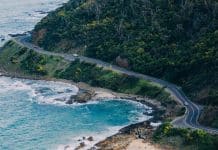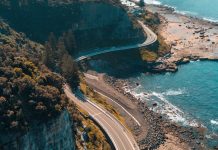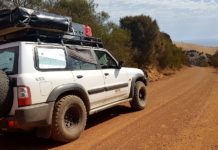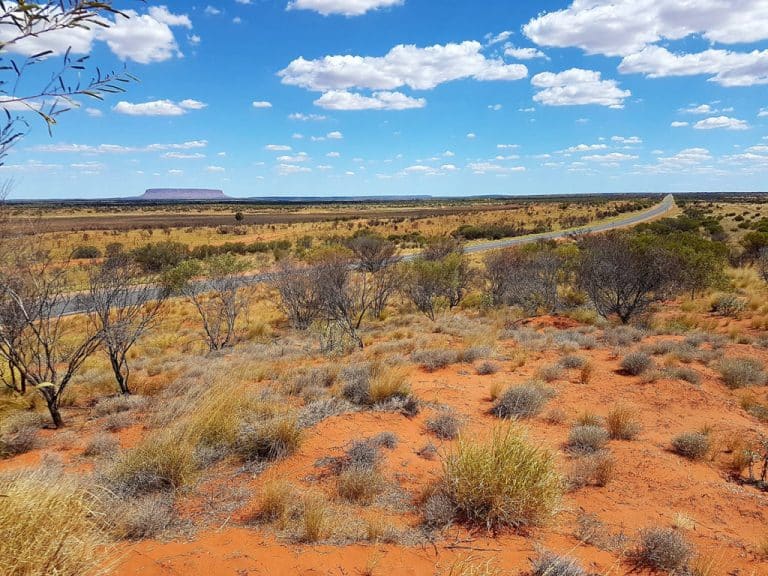
Are you planning your ultimate road trip through Australia and wondering if it is even allowed to camp in Australia and if so, where it’s possible? Don’t worry! Camping in Australia is a way of life for locals and tourists alike. An infinity of places as implausible as fantastic allow you to spend the night or stay a little longer. Some of these places are poorly or not at all equipped and others are very well equipped with all the amenities for a pleasant stay! Through this article, we will share all our tips to be unbeatable on the campsite! Because no, it’s not always easy to camp, it’s not just about pitching your tent somewhere!
Table of Contents
The Different Types of Camping
Sleeping in your vehicle
Australia being a huge country, the best way to travel it is to have your own vehicle! 4WD, van, car… whatever! The main advantage is that you will be able to cover long distances at your own pace. And that is priceless ! The country extends over 4000 km from West to East and over 3000 km from North to South, which are long distances.
During the trip, take the time to marvel at the many varied landscapes you will cross (sea, mountain, desert, bush, tropical forest, etc.). Another advantage, and not the least: accommodation! By choosing to travel the country with your own vehicle (purchased or rented), you are sure to have a place to sleep every night. No pressure to find a hostel every night. However, you will have to find a place to spend the night legally!
That’s not all… you will undoubtedly save money on your food budget. Vans are always equipped with a gas stove and all the necessary cooking utensils. 4WD are also generally equipped. Cars, not always, but it’s definitely possible to buy a stove (prices start at $25 at Bunnings). If you do not have a personal vehicle, you can also use the free barbecues available in some free camps, by the sea, in parks, etc.. Last advantage to owning your own vehicle: you will have access to remote spots (mountains, desert, bush…) that public transport does not always serve.
If you do not have your own vehicle, you can definitely rent one (campervan, car, van, 4WD). It will give you the freedom to travel wherever and whenever you want and you will be able to enjoy the real Australia.
If you are hiring a campervan you might already have everything on board that is needed for a camping road trip, therefore, this camping packing list will come in handy to double-check everything.
Renting a vehicle is a great idea, but if you are planning to travel for more than 3 months it is worth looking at secondhand vehicles to buy.
If you do decide to rent a vehicle, we recommend using an online comparison portal such as MotorHome Republic to receive the best deals!
Sleeping in a tent
If you prefer to sleep in a tent, that this is quite possible. Whether you install a rooftop tent on your vehicle or have a normal tent to pitch in the ground, it will be comfortable to be surrounded by four walls. For the real adventure seekers who want the real Australian experience, get a swag. A swag is a small mattress rolled up in a canvas bag to keep it waterproof. Whichever sleep arrangement you opt for, always remember to pack a pillow and a warm sleeping bag or small blanket! Very important camping essentials!
That said, if you don’t own a vehicle, the adventure immediately becomes a bit more complex… but quite feasible! Indeed, you will need to move around and will then be dependent on transport schedules. Bus, train, plane, carpooling… several options are available. It’s up to you to choose the one that suits you best according to your budget and your wishes.
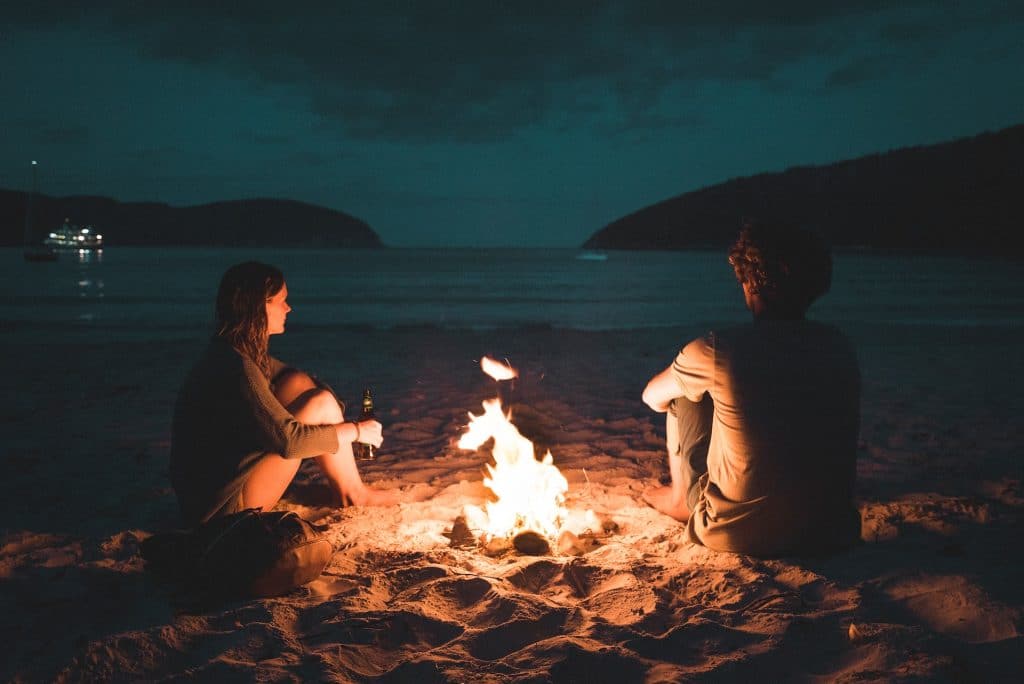
Where can I camp in Australia?
Now that we have listed the different modes of camping in Australia, beware of the regulations! Wild camping is prohibited in certain places. There will always be a sign explicitly telling you this, otherwise you will be fined by the rangers or the police. As a general rule, it is not allowed to leave your vehicle anywhere and spend the night there. Especially in cities or populated areas, you’ll quickly get a tapping that has it all.
There are various possibilities: caravan parks, campsites, rest areas and unofficial places. Here is an overview:
Caravan Parks
This is by far the most luxurious, but also the most expensive option. Caravan parks are very common in Australia and are signposted with a blue sign. They offer many facilities and facilities such as showers and toilets, laundry, kitchen and barbecues, one (or more) swimming pools, wifi, TV room or games room, bar and restaurant, playground, tour desk, etc. Some are very well equipped and have all the necessary comfort for a pleasant stay! These can be ordinary caravan parks or large chains (the main ones are Big 4 Holiday Parks and G’Day Parks) but also campsites located in national parks.
Caravan parks in Australia offer two types of stay: powered or unpowered. The price difference varies between $5 and $10/night. You should know that as obvious as it may seem, camping chains have higher prices than other caravan parks because of their prestige. They meet a number of standards, otherwise, their license is revoked. The price of a night in a camping chain varies between $40 to $65 per night.
On the other hand, private caravan parks are mostly managed by families and prices are much lower than a chain (about $20 to $50). The facilities are for some less modern and necessarily less important but this does not mean that you will have an unpleasant stay.
Campsites
Campsites are also widespread in Australia. These are very cheap and sometimes even free (depending on the equipment and location of the campsite). Here you can pitch your tent and park your camper overnight.
National parks are also equipped with campsites. You will find more than 500 across the country! This is a very good alternative when you want to stay several days in a national park and/or you are in a remote place. They have basic facilities such as toilets and showers as well as barbecues and/or picnic tables. Showers are often free. These are managed by rangers and very often they use “self-registration” system. This means that there is no reception but rather a locked box. You leave the money in an envelope with some personal information (rego, number of people / nights) and slip it into the box.
In some national parks, rangers go directly to each location to collect payment. Depending on the state, you will also have to pay the entry fee to the national park. Passes can be purchased to access all the National Parks of the State. This pass system considerably reduces the cost of your stay. NSW, TAS and WA state passes cover your entrance fees only. You will have to pay for your camping night(s) in addition to this price. You can buy them directly online on the government website or directly at a Visitor Center.
Free Camps and Rest areas
These spots allow you to sleep for free in your vehicle or in your tent but usually parking time is limited (24h to 72h). These sites are not real campsites strictly speaking but rather rest areas and sometimes even car parks. Comfort is rudimentary. Sometimes there will be no equipment, and other times you will have access to toilets, picnic tables and/or showers (free or paid, cold or hot).
In order to have easy and quick access to all the free camps and paid campsites, we strongly advise you to download the WikiCamps application. Another option is to go to the tourist offices as they often have a flyer with a list of all the accommodation in the city and the surrounding area. Finally, check out Facebook groups as travelers often share their tips about accomodation.
Unofficial Places
Finding your tent somewhere in the wild is a feeling of ultimate freedom – despite the lack of water, showers and toilets. This type of camping is usually not allowed. Exceptions are, however, if it is allowed in the whole area. If you want to take the risk and still want to wild camp in one place, you should make sure that you are looking for a quiet and abandoned place and leave the place as you have found it. Of course, that applies everywhere.
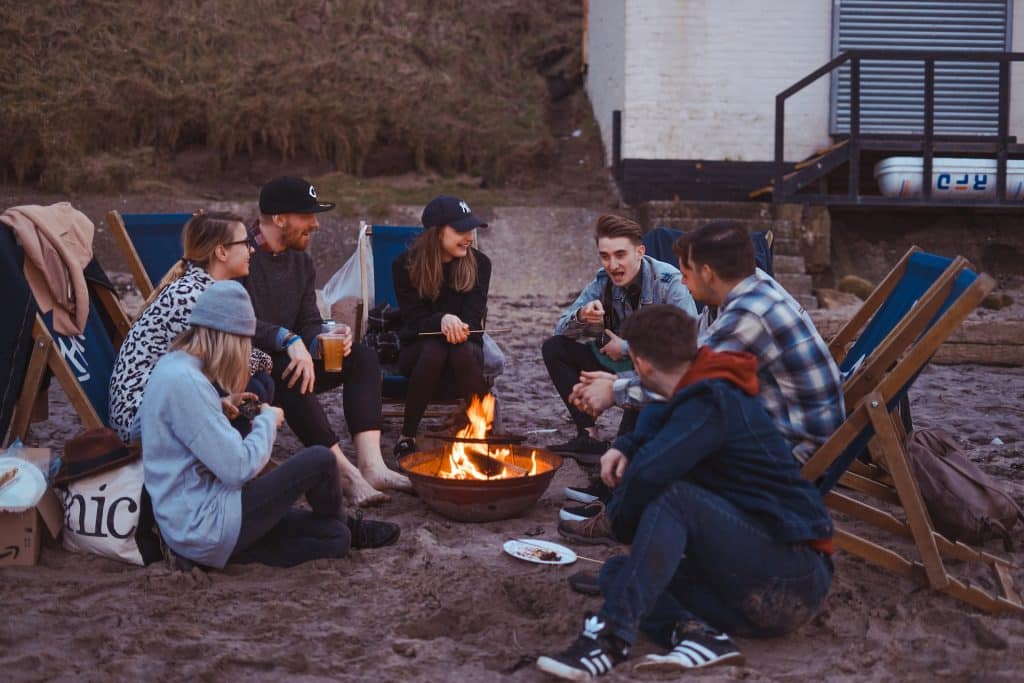
The best camp spots in Australia
It is obvious that the following list is far from being exhaustive since there are many Australian campsites that are worth knowing and trying! Depending on your desires and your itinerary, you will find completely different campsites: some hidden deep in the bush or by the sea with your feet in the sand, others located in the heart of the lush mountains or even in the most beautiful tropical forests in the country!
You will find below, two good spots by state, a free camp as well as a paid campsite. Let’s go!
Queensland (QLD)
- The Boulders Free Camping Ground : beautiful spot close to the river. toilets and Showers available. No cell-phone coverage.
- Safari Lodge Cape Tribulation : this accommodation in the heart of the Daintree Rainforest offers cabins as well as campsites. Swimming pool, catering and excursions on site. $18 to $165/night.
New South Wales (NSW)
- Green Patch Jervis Bay : crystal clear water and white sand! This free camp is a small treasure. Nestled in secluded Green Patch Bay, breathe in the sea air and relax by its fine sandy beaches. Take a dip in its magnificent crystal clear waters. Restrooms and campfires available.
- Diamond Head Camping : it is one of the most popular campsites in Crowdy Bay National Park. Picnic tables, barbecue, showers and toilets and parking available. $24.60/1 to 2 people/night.
Victoria (VIC)
- Sawpit Free Campground : this large forest camping area is the perfect place to enjoy the surrounding wildlife (wallabies, koalas, kookaburras, parakeets). Toilets and picnic tables on site and hiking trails nearby.
- Tidal River Campground : main campsite of Wilsons Promontory National Park, it is located in the heart of one of the best sites in Victoria. Several ranges of accommodation are offered. The pitch is $65 for one night.
Tasmania (TAS)
- Mayfield Bay Free Camping : located 20 minutes south of Swansea, this free camp is an incredible spot that offers you a breathtaking view of the Freycinet peninsula. Sanitary facilities available.
- River’s Edge Wilderness Camping : this extraordinary wilderness setting is found on the banks of the River Russell at Lonnavale in the south of the island. $14 to $18 per site/adult + $2 for a 5-minute shower.
South Australie (SA)
- Kimba Free Camping : this free camp is worth the detour! Clean and well maintained, it is located 5 minutes walk from the main street. Toilets, showers ($1) and huge kitchen on site!
- Deep Creek National Park : this superb campsite with few spots (17) has spectacular views of the coast. Several hiking trails nearby. Toilets, picnic table and campfires available. $24 site/night/1 to 8 people.
Western Australia (WA)
- Cape Range National Park Osprey Bay : paradise on earth exists… Welcome to Osprey Bay! The national park adjoins the sanctuary area of the Ningaloo Marine Park. Toilets and picnic table at the campsite. It is the only campsite in the area with electricity. $22/2 people/night.
- Lake Brockman Tourist Park : Located in a natural environment in the very heart of the forest, this campsite is only 10 minutes from the village of Harvey. Campsites or cabins on the lake are available. $15 to $22/person for a site or $280/night in a cabin/6 people.
Northern Territory (NT)
- Corella Dam and Clem Walton Park : this spot extends all around a lake and a dam. This free camp is located 70 km east of Mount Isa. We strongly recommend it to the more adventurous among you (it has no facilities, so no toilets or showers). If you walk around at the edge of the water, you will certainly have the chance to see crocodiles.
- Litchfield National Park : many sites allow camping, that said Florence Falls is pretty good! It is equipped with barbecues as well as showers and toilets and even sinks for washing dishes. Don’t forget to take your bathing suit. $12/adult/night.
Camping essentials
First thing to do when you arrive in Australia and plan to go on a road trip: buy a local SIM card. The best phone network is Telstra. It is the one with the largest coverage in the country. The rates are higher than in Europe, you will need to plan a sizeable budget if you are addicted to your phone and especially to the Internet! Plan $40 for 50GB, unlimited calls and texts in Australia.
Useful apps
- WikiCamps or CamperMate (if you do not wish to pay for an application)
- Google Maps or Waze as a GPS
- Offline maps that you will have taken the precaution of downloading upstream with Google Maps or via Maps.me
Guide and map(s) of Australia
If there is one essential accessory for a road trip in Australia, it is THE travel guide! You will find all the information you need for your trip and even some that you would never have thought of. Accommodation, tourist sites, restaurants and pubs, ideas for outings, culture and traditions of the country, climate, emergency numbers… you will have absolutely everything you need to know available, and what’s more, grouped together in a single and even guide. The maps will allow you to get an idea of the locations (cities or points of interest) and the distances to be covered.
Download the Backpackers Guide

Our FREE 400-page eBook contains all the information you need for your WHV in Australia :
- administrative procedures
- transport and ways of travelling
- jobs & +500 fruit picking contacts
- regions and practical life
- numerous discounts
Kitchen essentials
Having a basic kitchen set up while road tripping around Australia will not only save you money, but you will have some of the most incredible kitchen backdrops ever! Imagine cooking a curry on the beach in Western Australia and watching the sunset over the ocean under a candy coloured sky?! How dreamy! However, this cannot be achieved if you don’t have the following on board:
- A gas cooker
- A 3KG gas bottle at minimum
- A lighter for backup
- Cutlery
- Plates and bowls
- Pot with a lid
- Frypan
- Spatula/mixing spoon
- A sieve
- Vegetable peeler
- Can opener
- Kettle
- Sharp knife
- If you do not have a fridge installed, then you will certainly need a cool box (Esky) to keep your fresh food and beer cold!
Please note that having a gas cooker is necessary as some regions during the summer have total fire bans therefore cooking on a fire is completely out of the question. Always check the region if you are allowed to have campfires.
Electronic equipment
An inverter is small device that converts electrical current from a vehicle’s batteries into alternating current, the same type of electricity that is used at a wall outlet. An inventer must have at least 12 volts and can go up to 240 volts. Simply plug it in while driving so that all of your electronic/electrical devices (fridge, lights, batteries, computer and mobile phone, etc.) work and/or recharge. The cost varies depending on the number of volts chosen, the quality of the product. For less than $100, you can find used ones otherwise at Bunnings, the lowest price for this type of product is $170.
It is also worth having a GPS or offline maps on your phone, a boom box for road trip singalongs, a camera to capture amazing moments and a laptop. You will be very thankful for those camping essentials.
Bottled water & Gasoline
In Australia, always have a water supply of at least 10L/per person. This reserve could be useful in case you are in a remote place without access to shops or if you break down, for example. This supply can also come in handy if you need water for cooking (pasta or rice, for example). Indeed, it is not everywhere that you will be able to find drinking water, and it happens that in some places, the tank is empty!
For the same reason as above, it is always better to have at least one can of gasoline in your vehicle. It is not uncommon to break down in the middle of nowhere in Australia. This applies in particular to the center of the country where petrol stations are further apart from each other. Sometimes you will have to drive long distances before you have access to a station.
Things that make your life easier
Overall, you do not need a lot when road tripping through Australia. Afterall, less means more these days. However, some things that may make your life easier are:
- A camping shower. It is one of the favorite accessories of backpackers, and for good reason… even if many campsites are equipped with showers, you will sometimes find yourself without anything and that for several days. Better to plan ahead! Whether solar or not, we advise you to have one in your vehicle. Count $25 at BCF for a basic shower with bag to fill + hose. If you want more comfort, you will find showers with a curtain to attach to your vehicle and even closed shower cabins. The price ranges from $110 to $250. Although this is obvious in Australia, remember to always have a swimsuit (as well as flip flops), especially in public showers.
- Boxes/crates to help store your clothes and food. It will help you to keep organise and have some space in your vehicle.
- A headlamp, definitely useful when you need to walk around at night!
- Mosquito/ Fly nets. This ingenious gadget will be necessary, especially if you are traveling through the Australian outback in the bush and the desert. Indeed, the center of Australia is a cradle for these little insects that will not stop coming to rest on you, whether on your face or your body. We strongly advise you to get one even for a simple road trip because you will find flies in many other states (Queensland or Tasmania for example). This accessory will not cost you much, cont between approximately $6 and $10.
- Insect repellent / coils
Tools
We all hope to escape a breakdown. Nevertheless, one should be prepared in case of an emergency. Your vehicle should contain a basic tool kit including:
- A jack
- Torque
- Spare tyre
- Spanners
- Screwdrivers
- Socket set
- Compressor
- Spare engine oil
- Spare coolant
- Ducktape
- Zip ties
You might not be able to do a lot of repairs yourself but with the above tools, you should be able to get out trouble and to the nearest town. Keep in mind that Australia has a lot of dirt roads and this is where most problems occur. If you intend to go off-road four-wheel driving, then you will need to recovery equipment to your camping packing list.
Extra items
Sometimes when you travel you forget to slow down and relax. Every so often you need to take a day to relax and refresh your body. On days like these, it is good to have packed a hammock, offline movies, a deck of cards or other board games, some books and of course a beach towel!! Those are essentials when going on a camping trip.
Alrighty! With all the items now ticked off the camping pack list, you are now ready to hit the road!! Fasten your seat belts and enjoy everything Australia has to offer!
Where to buy your camping equipment?
You will find all the camping necessities (various equipment such as tables and chairs, fridge, dishes, shower, solar panels, bedding, fishing accessories and much more!) in the following stores:
- BCF
- Bunnings
- Supercheap auto
- Kmart
- Big W
- You can also go to second-hand shops like Cash Converters. You can take a trip to Salvos, Vinnies or Red Cross but you will be less likely to find equipment, you will find accessories like shoes or clothes instead.
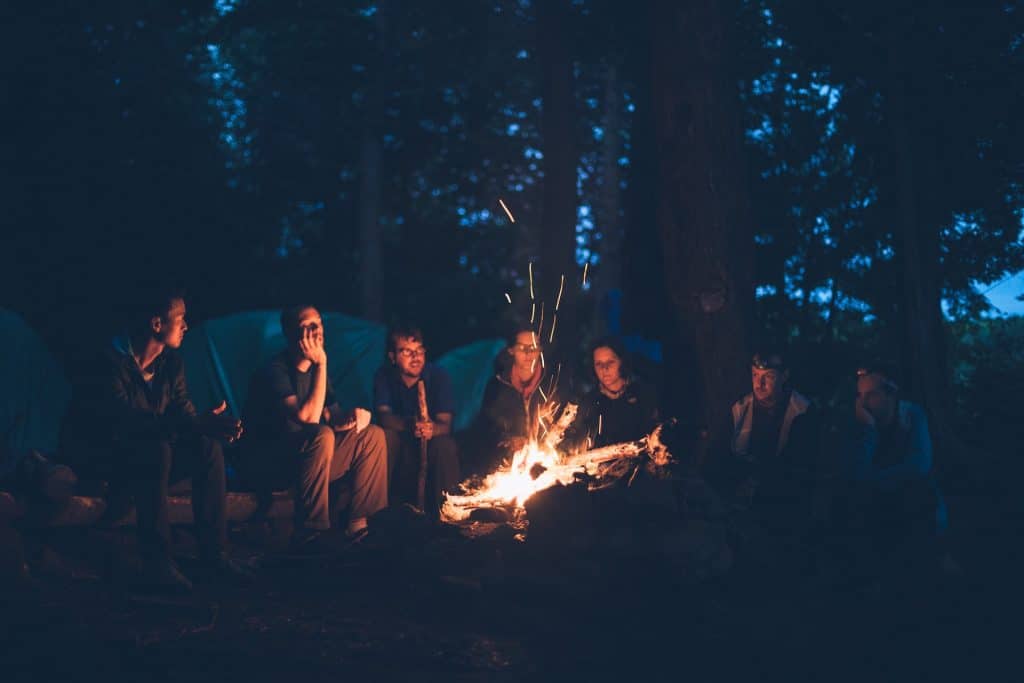
Dangers and risks when camping
Insects and animals
You will find insects and animals absolutely EVERYWHERE, and even sometimes in places where you least expect them! Know that nightfall is THE perfect time for them to go out. Huge spiders and poisonous snakes, mosquitoes and flies… get ready for an adventure full of surprises and twists! At the risk of scaring you a little more, always beware of insects that sneak into your vehicle… especially spiders (Huntsman).
Always be careful where you set up camp for the night, especially if you have food with you. Indeed, depending on the state where you travel, some animals will not hesitate to get closer to you like a dingo or possums for example. Northern Australia and the state of Queensland are the places where you should be most careful since some campsites or free camps are located at the edge of the water and crocodiles might be there. . Always watch where you step, especially at night.
Weather risks
Australia is a country that covers almost 7.7 million km2. The climate is very different from one state to another but it can also change very quickly during the day. Bright sun, drought or humidity, rain and floods, snow, hurricanes, sandstorms, bush fires… absolutely anything can happen. So be careful at the slightest change and check the weather regularly! If you sleep in a tent on the ground or in a roof tent on top of your vehicle, always check the weather. You can quickly get soaked with the rain… and quickly get cold during the winter. Always have a very good blanket or sleeping bag.
Australia’s camping culture
Australia is a country of wide open wild and natural spaces! As soon as you move away from the big cities, the accommodation options are limited. Camping quickly became the main activity over the years. Indeed, it allows you to travel many miles even in the most remote spots, and you know that you will ALWAYS find a place to sleep.
Many Australians own a van or campervan and are doing road trips. Camping turns out to be the perfect compromise to combine travel, discovery and relaxation without spending too much money. It is an affordable and cheap way to go on vacation (and that, several times a year!). Fine sandy beaches and turquoise water, heavenly coves, rainforest, countryside landscapes and mountain ranges, national parks, there are countless different places to camp in Australia. Camping offers many opportunities to be closer to nature. Admire incredible sunrises and sunsets, marvel at the magnificent skies of the outback and the Milky Way, hear the sounds of nature, come face to face with Australian animal species, hiking… everything is made to make you happy!
Practicing activities or simply walking, cooking, chatting, having a good time… In addition, it must be said that Down Under, the weather is (very often) sunny, hot and dry.
Camping is a long-standing tradition rooted in Australian culture. And this since the first colony at Botany Bay. In the 19th century, the “swagman” as it was once called, referred to a temporary worker traveling on foot from farm to farm. The few belongings he had were rolled up in a thin sleeping pad. At that time, vehicles were not common and it was necessary to get around on foot.
Camping Hacks – Tips and Tricks for your road trip in Australia
1 # Check your car in advance
If you are purchasing a vehicle to travel in when you arrive in Australia, it is highly advised to have it thoroughly checked over by a qualified mechanic. Most backpacker cars are 20 years old and have driven several 100,000 kilometres. Make sure your coveted vehicle drives for another thousand kilometres before you buy it.
2 # Check the oil and coolant every few days
Whether you are travelling in your own car or rental car check the oil and coolant levels to avoid any engine damage. Due to the hot temperatures and long distance it is also important to check over the radiator once every couple of weeks.
3 # Check fuel prices and use discount promotions
You will spend a large part of your budget on fuel. To keep these expenses down, compare fuel prices online beforehand and take advantage of the discounts offered by major supermarkets such as Coles and Woolworths, which offer 4 cents off per litre at selected fuel stations.
4 # Do not drive at night!
Wildlife accidents with kangaroos are not uncommon on Australian roads, so avoid driving at night.
5 # Plan money for service and parts
This applies again to everyone with their own car. Your car is probably old, and you will drive many kilometres. To make sure it does not fall short of your goal, change your oil every 10,000 kilometres and plan to spend money on replacement parts.
6 # Backpacker cars can be recognized from afar
The painted van, the 4WD with a rooftop tent or the twenty-year-old car with a rooftop basket full of jerry cans. In most cases, you recognise backpacker cars from afar and is always a great opportunity to meet new people.
7 # Plan your trip
The best way to travel Australia is to follow the seasons. During the wet season (summer months) try to avoid the tropical north and during the winter months (June – August) avoid the southern regions. It is best to travel South Australia, Tasmania and Victoria during the summer and explore Queensland, the Northern Territory and North-West during the cooler winter months.
More information can be found here: Seasons and climate in Australia
8 # Cook on your own when traveling
The #1 way to save money while on the road is to cook your own meals. Make sure before starting your road trip that you have a reliable gas cooker with at least a 3kg gas bottle. Another hot tip for when you are in towns / cities, check local parks and beaches for free BBQ’s, save your gas! Great camping hacks!
9 # Build a high bed base
If you need to build a bed base in your camper, build it higher enough to store the boxes underneath.
10 # Invest in mosquito nets
To avoid getting annoying mosquitoes and poisonous animals into your car, you should invest in mosquito nets for the windows.
11 # Rooftop storage
Roof racks or a rooftop basket is a great option to store any items that do not get used daily. This will allow for some room in the car, making it a more comfortable journey.
Related Articles:




















